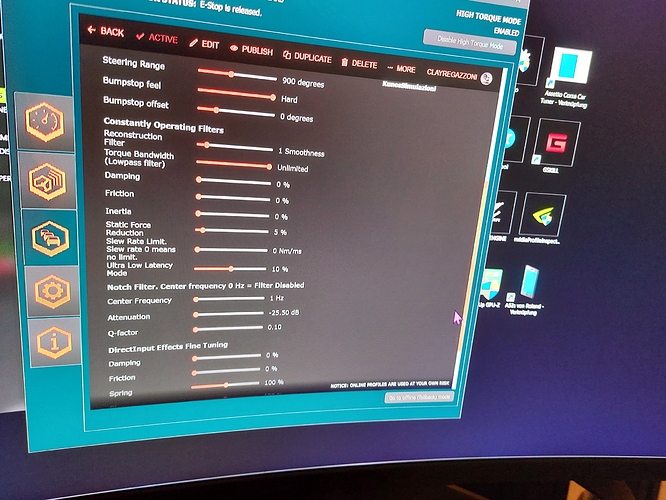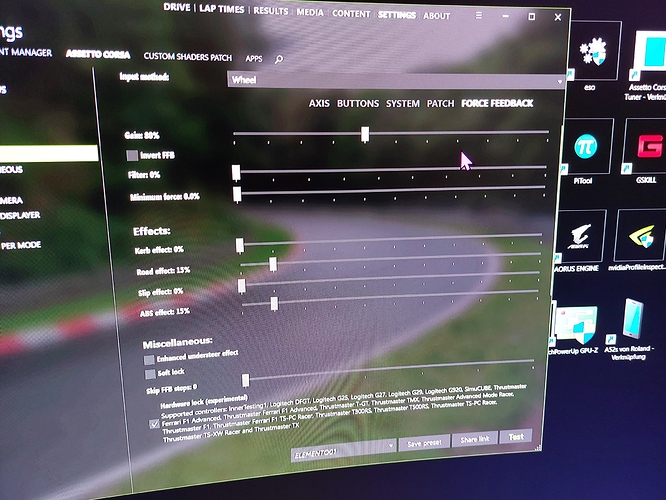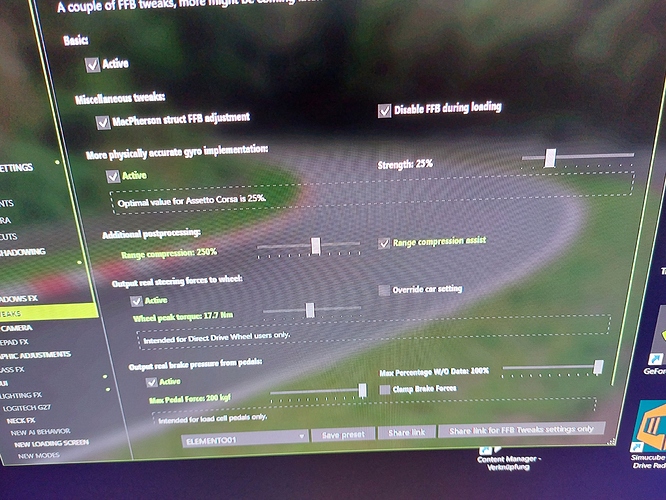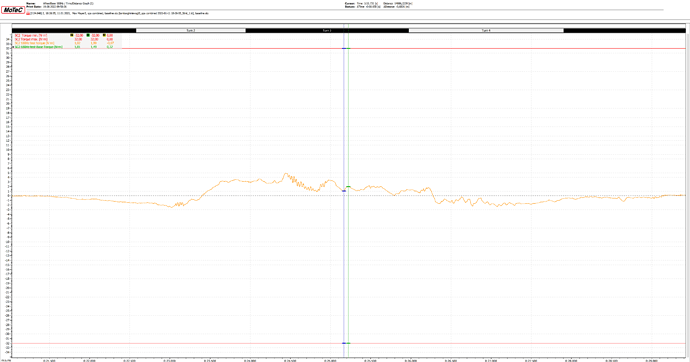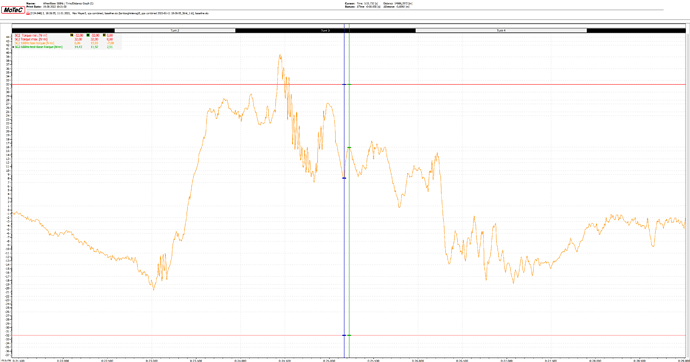Well, when we talk about the 10nm wheelbase, this discussion takes a very different turn: 
AC offers a lot of settings: overall all gain, old gyro, new gyro, FFB tweaks and per car FFB, immersive stuff like track, abs, curbs… On top there is non official software like FFB clip with DD mode, tyre apps with arcade mode, sidekick, camberextravaganca ammo. Think is impossible to claim “I’m right/others wrong”. I use 100% in TD, but I have a Sport R2. I lower overall gain in AC. Others use full torque with a Pro R2 AND 100 overall but then make concessions somewhere else. We end up hating each other because of… what? We have the best hardware, everyone is enjoying it. I know that I am NOT the hero above all and think there is no such person. Would be interesting to test a car on a track with different settings without knowing who is the preset from. Just a Simucube 2, all with the same steering wheel. I maybe would be surprised how good settings are I always denied (although I doubt 




Why? You can go to low on both bases.
That is of course correct.
What I mean by that is that with a 10NM base it makes sense never to turn it lower, because you set this in iRacing, for example, how much NM you really want to have.
In addition, as far as I know, details on the track are then lost because the dynamics of the base are restricted.
That was my understanding of what Barry was suggesting also. Is it fair to say then that we do not need to worry about losing linearity or optimal response from the SC2 servos regardless of where we set the strength in True Drive? That has been my assumption all along but it would be great to get confirmation of that.
Yes, it is fair to say.
For the past few weeks I’ve gone back to leaving the TD strength at 100% for my pro and lowering the game win to 30% and 100% the FFB per cars.
And there this morning I read the thread about the possibility of lowering the engine speed ains the static force, I had already tried this without really looking further, I will deepen its settings.
Engine speed, you talk about slew rate limitation?
Static force reduction is different from slew rate limitation (obvious, because of the 2 settings, maybe stupid remark)
Yes we speak well of the same thing content manager, with the difference that does not use the FFBTWEAK or CLIP I know more, I keep the original FFB of the game.
I have for principle, that if in a game it is necessary to add an application external to the game to improve the ffb, it is that of origin the ffb of the game is very bad.
Traduit avec DeepL
In fact CM is also an external software added to the original game. Aswell the older gyro. These FFB settings are part of official CSP package, also kind of an external software
But why you use CM then? And FFB clip is a controller, and has nothing to with the quality of the FFB. It’s nothing but a torque tool, and not an FFB extension/tweaker/booster
I use CM for all the management of the game and CSP -SOL , I activate or deactivate some parameters that I don’t feel I need including the FFB clip, of course I set the ffb via CM since I don’t use assetto corsa anymore as a game launcher, and I activated the original gyroscope and not the one of CM that I find less good .
Sorry it’s getting longer again. 
Unfortunately I don’t have AC, so I’m not familiar with the settings. But in general, the relationship between Game setting and True Drive setting is like preamp and amp. If you turn the setting too low in game, you will not clipping at the top, but you lose a lot of dynamics and a lot of detail at the bottom.
The dynamic between the points in this case is 0.97Nm . Not much, but nothing of the FFB signal is lost at the top. This is case 1 that must be avoided.
The second case to avoid is overdoing the in-game setting. This gives you a lot of dynamics and details in the lower torque band. But at the upper band you lose far too much by clipping. But at our test points, the dynamics increase to 14.77Nm.
The compromise looks like this. A little clipping around the top and a little loss of dynamics and details around the bottom. So the dynamics at our test points still remain at 7.88Nm, but without losing too much through clipping at the top.
For me, an accountant and business economist with 2 right hands (I’m a left hander  ), everything technical and mechanical has always been something fascinating. Your explanations give me a wider understanding of feeling FFB. Maybe a stupid question:
), everything technical and mechanical has always been something fascinating. Your explanations give me a wider understanding of feeling FFB. Maybe a stupid question:
At Spa, eau rouge, my car is getting very light. As it would be close to taking off. In fact it already did, when my tyres were cold! A terrible crash, even in simulatio, luckily no harsh impact…
I can feel very good all the different types of curbes, under and oversteering. What interests me is the exact difference between vibrations coming from FFB and from settings generating them. They can add a bit of immersion/sensation.
Now: Where is the point where overdosing torque ruins this ( of course before clipping)?
If there is, can you see this in your analysises?
How does bad FFB looks like?
Can I send you a graph to see how you interpret it, so that I can compare your technical view with my driver view?
You are lucky to understand, between the English and the rough translation into French I don’t quite understand what you are getting at.
You say that if we lower the power too much we end up with clipping, wouldn’t it be rather the opposite?
I have already tried settings with damping and friction, I don’t like very much this feeling of driving in game, I prefer settings as simple and raw as possible, adding filter reconstruction.
Yes, of course too much power will end up in clipping. I was asking @Purple_Red, our engineering genius. I think he could easily be the Adrian Newey of eSports.
Sorry if I mistakenly sent it to you my friend
@getmlh
Thanks  ! No, you were right! My mistake…
! No, you were right! My mistake… 
@CLAYREGAZZONI
Sure, send me your diagram. 
Yes, suboptimal FFB can be recognized in this way. When the game gives an FFB signal to Motec. This works best with rFactor2, with iRacing it also works (but it’s more complicated) and with ACC it doesn’t work at all.
However, what good FFB means can be very different for each person.
Motec is like a “recording tool”. It is important to understand where it picks up the signal. Because Motec only picks up the signal between the game and the Simucube. This means that ingame settings will be recorded by Motec. But settings in the True Drive software have no effect on Motec.
By the way…
Does anyone have a Motec file from AC?
It is a very good explanation and matches what FFBClip app author (Atle) was describing for maximizing power output while avoiding clipping.
BUT, even him quit applying this principle when switched to DD wheel, it didn’t matter much with so much torque available and based on his and other users (myself included) tests the final results of maximizing game output or servo max torque were the same as long as you don’t go into clipping area and have the same overall gain.
This is also confirmed in this very thread by GD engineers.
As audiophile myself I am completely with you on pre-amp/amp analogy, but I believe in this case the situation is a bit different and more like dealing with digital volume control with bit depth exceeding the actual signal.
Yes and i totaly agree! But Tommi is talking about the “True Drive Overall Strenght” and that is different to the ingame setting. Every Game got something to adjust the Output of the FFB… which is some sort of multiplierer. Rfactor2 got the “Car specific multi”…Iracing got something weird…anyway. For example…At some point on the track the game wants 100%(1)FFB to the right. Now, the Game-Engine multiplies it with your ingame setting, lets set it to 80% ->0.8. So (1 x 0.8) =0.8 (this is our “preamp output value”). The Output of the game will be 80%FFB to right and that value goes to the True Drive Software.
At this point another multipliere acures, the True Drive Overall Strenght. Our SC2 Pro got a max output torque of 25Nm multiplied with the TDOS, lets take 50% -> 0.5. (25Nm x 0.5) =12,5Nm Maximum Output Torque.
The full calculation is: (1 x 0.8) x (25Nm x 0.5)=10Nm
The FFB turns the Wheelbase-shaft with 10Nm.
